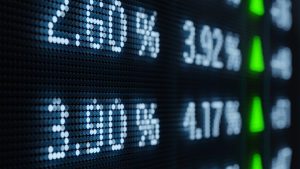Photography by Getty Images; Illustration by Bankrate
Whiplash may be the best word to describe the stock market recently.
The announcement of Trump’s reciprocal tariffs earlier this month sent investors into a frenzy. The S&P 500 teetered on the edge of bear market territory, at one point dropping almost 19 percent below its all-time high on Feb. 19.
Then stocks shot back up after Trump announced a 90-day pause on most reciprocal tariffs, with the exception of China. On April 9, the S&P 500 experienced its third-largest gain in a single day since 1980. By April 10, stocks tumbled again on mounting worries over the economic impact of Trump’s multi-front trade war.
Financial experts warn this likely won’t be the last of extreme market volatility this year. Investors will need to stay patient, they said. Despite the volatility and heightened anxiety from Wall Street, the long-term outlook shouldn’t change for most individual investors who plan to remain active in the market for the next 10 years or longer, according to CFP and Bankrate Analyst Stephen Kates and MFS Managing Director Jonathan Barry. It may actually be an opportunity for long-term investors to buy more stocks at lower prices, they said.
“Stay the course; don’t do anything drastic,” Barry said. “Markets have shown they are extremely resilient and can get very meaningful returns for investors, even after these big drawdowns.”
If you’re investing for the long haul and are worried about your investments, this chart may help calm your fears.
A history of stock market recoveries
Sharp, sudden market declines can make investors feel inherently panicked, whether they’re mom and pop investors or institutional investors. Many react by selling stock or pulling out of the market altogether. But history shows that isn’t wise in the long run as financial markets typically rebound, with shares recovering their value over time.
Take Black Monday, the dot-com bubble and the 2008 financial crisis as examples. Those three market events caused the S&P 500 to plunge dramatically, ranging from a 33 percent decline during Black Monday to a 57 percent decline during the 2008 recession. However, when you zoom out, the S&P 500 tends to bounce back within a year after a bear market and posts even higher returns over longer periods, according to Barry.
“History has shown markets always bounce back,” Barry said. “Part of it is just the resiliency of the economy; some of it is just the natural cycle of how markets work. Markets do go down; they don’t always go up.”
Five years after the Great Recession, for example, cumulative returns for the S&P 500 were at 178 percent. Those cumulative returns skyrocketed to 306 percent after 10 years. The stock market fell back into bear market territory during the COVID-19 pandemic and again when inflation spiked in 2022, but what followed was two consecutive years of strong performance. The S&P 500 cumulatively returned 153 percent on stocks five years after the pandemic.
While the chart focuses on returns within a single equity index based on price, Barry said it’s important to recognize that over time dividends do account for a large percentage of investors’ returns beyond just the appreciation of the equity they hold.
If history tells us anything, the stock market typically rebounds after it crashes and keeps going up in the long run. All too often, investors who sell off in a panic during market dips end up cementing their losses and might even miss out on a market rebound.
A downturn in the market is a gift to the long-term investor, offering the chance to buy more high-quality companies at lower prices.
— James Royal, Bankrate Investing Analyst
How investors should handle stock market volatility due to tariffs
Worried about your portfolio amid the market volatility? Here are the most important steps to take with your investments, according to financial experts:
Read the full article here









